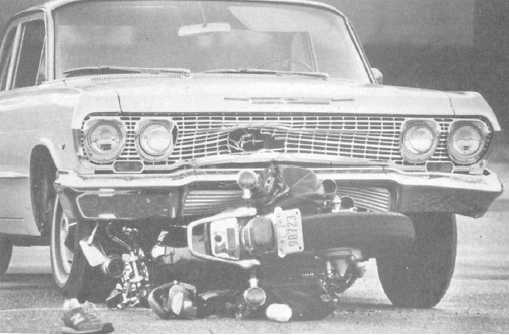JO1 Jim Bryant
Figure 3-5.—The Navy Journalist will write about many types of accidents, such as this automobile vs. motorcycle mishap.
Coaches and managers for details about team
members, lineups and rosters, game plans,
quotes and information about a contest,
especially a contest you did not cover yourself.
Team members for accounts of what happened
in the game. Be cautious. Many losing teams
tend to blame the loss on the officiating,
whether they lost by one point or 30 points.
Official scorers for game statistics and score-
books. If you run a box score of the game, be
sure your stats match those of the official
scorer.
Fans for color and sidelight information, where
appropriate. Often used in sidebar stories, fan
reactions can help tell the story of a team’s
success or misfortune.
Officials are impartial and usually refuse to
comment. If an official’s call is vital to the story, do not
expect him to explain or justify it unless it is a matter of
rule interpretation. Never ask an official about judgment
calls (balls and strikes, close calls on the bases, whether
a receiver was in or out of bounds when he caught a
pass, whether a basketball player traveled, etc.).
Officials
are,
however,
legitimate
subjects
for
personality and rules clinic features.
Additional sports coverage guidelines (including
help on compiling statistics) maybe found in the latest
edition of The Associated Press Stylebook and Libel
Manual.
THE ACCIDENT STORY
LEARNING
OBJECTIVE:
Identify
the
structure of the accident story and the methods
used to gather accident news.
Five sailors are killed when one falls asleep at the
wheel of his car after a weekend liberty.
A young Navy ensign dies in a flaming plane crash
when something goes wrong with his jet during a routine
training hop.
A Marine accidentally shoots a buddy with a gun he
did not think was loaded.
An airman crosses an aircraft flight line and walks
into the blades of a spinning propeller.
A civilian painter plunges to his death from a three-
story Navy building when the lines in a scaffold break.
An explosion at a base facility kills 15 people and
injures 35 others.
A Navy dependent child dies in an ambulance after
drinking something from the family’s medicine cabinet.
Accidents and disasters such as these take hundreds
of lives each year. In addition to destroying life and
property, they cause untold pain, misery and suffering to
the victims’ friends and relatives.
Yet, despite the undesirability of this type of news
from the Navy’s viewpoint, covering and writing
accident stories is part of your job (fig. 3-5).
3-17



